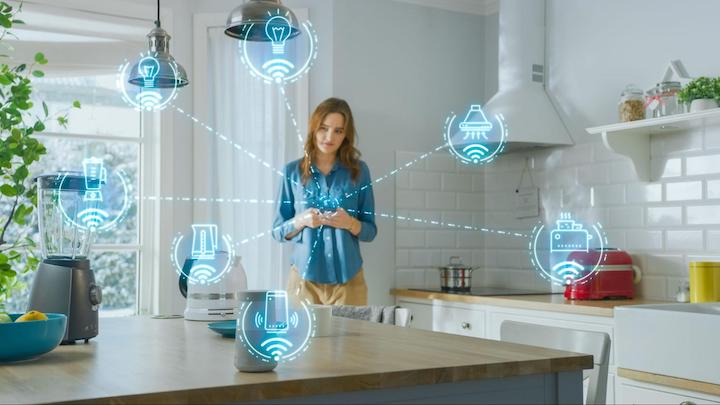Time to read: 4 min
This article is based on Breadware’s IoT Product Development in 4 Smart Steps, which outlines the four phases of IoT Product Development.
The Internet of Things (IoT) market has exploded in recent years, and now IoT-connected devices outnumber non-connected devices. Thus far in 2023, 3.22 billion new IoT devices have come online, so now the total number of active IoT devices is over 15 billion. That growth is only expected to continue in the next seven years – according to Exploding Topics, there will be over 30 billion connected devices by 2030. It’s also estimated that nearly two-thirds of enterprise companies will adopt IoT to help reduce expenses, optimize assets, and improve internal safety and security.
So how does this IoT boom affect product developers and manufacturers? Building a product in an era of connected devices requires an IoT development life cycle that’s strategic and focused. At Breadware, the IoT product development cycle is broken down into thinking, planning, and building a new, intelligent product initiative. Within those areas, there are four key phases that every company should consider: Project Definition > Alpha Prototype > Beta Prototype > New Product Introduction.

Within each phase, you’ll find additional, necessary steps to ensure your product launch is successful.
Phase 1: Project Definition
Just as with any new product, you begin with an idea. The project definition is the crucial first step that flows into the other development phases. For projects that don’t have a clear and full product specification, this phase is the best place to start.
The Goal
Begin by understanding your desired goal, which is to come away with a succinct product vision, a technical product architecture, at least one physical design concept, pricing estimates for production, and a detailed product development plan.
Step 1: Feasibility Study
Then review marketing research, similar products, user needs, timeline, and the development team to prepare a feasibility report that provides direction and technical strategy for product development. This is a crucial first step because it begins turning your idea into a tangible product. Get it right, and your plan will not only prepare you for the next step, but also prevent you from heading down a more costly and time-consuming path.
Step 2: IoT Workshops or Brainstorming
Having done your homework with your feasibility study, it’s time to l;earn more about specific IoT needs. On-site brainstorming workshops and IoT training sessions are designed to educate, engage, and inform participants on the IoT product development journey. If you work with Breadware’s engineering experts, we’ll walkthrough specific development processes and facilitate strategy brainstorm sessions.
Step 3: Technical Architecture
Next it’s time to build the foundation for our device, by creating a mechanical, electrical, firmware, cloud, mobile, and database architecture that best meets the market needs, usage factors, and constraints for the product. This step is a common stumbling block for new IoT initiatives, because it uncovers the tech stack needed to realize the product. This step is technically nuanced and involves multidisciplinary teams, which increases the complexity of the project.
Step 4: Proof of Concept
Now it’s time to start building! Development of a rapid prototype, generally using off-the-shelf hardware and software, will shed light on the key “gating” questions around the technology, features, user interface, and unit cost. From looks-like to alpha prototypes, this is when some of the biggest unknowns show up. Low-fidelity, quick turnaround prototypes will illuminate potential pitfalls sooner than later, which will save you a lot of money and time in the long run.
Step 5: Product Requirements Document
Create a preliminary product requirements document (PRD) that clearly articulates the product look, feel, functions, and feature-set. This document becomes a blueprint to guide product development of IoT throughout the process. After the due diligence of the first 4 steps, the compiled findings should take form in a well-defined PRD.
Remember, the right product development strategy will help you build a better product, lower your time to market, and grow your bottom line.

If you want to learn more about all four phases of the IoT product development cycle, check out our articles or see real case studies, and more.
Fictiv FAQ
Thanks for reading this article written by our friends at Breadware. To provide additional context, we wanted to share answers to some common questions about IoT product development:
What is IoT product development?
The IoT product development process is utilized for designing and bringing to market any device or system that has internet connectivity and communicates with other devices or services. IoT products commonly comprise hardware, software, and internet connectivity. These devices perform various tasks, exchange data, and can interact with both humans and other devices.
How does IoT help in product development?
IoT is a highly beneficial tool in product development. With the ability to collect and exchange massive amounts of data, IoT provides designers and developers with the most accurate and up-to-date information about a product’s use, performance, and issues. This information allows designers to improve product design through data-driven decisions and obtain real-time insights into usage and customer experience.
How do you create an IoT product?
For more tips on creating an IoT product, check out our Guide to IoT Product Development.
What is an example of an IoT product?
The following are commonly found IoT products:
- Cellphones
- WIFI connected thermostat
- Fitbits
- Smart refrigerators
- Wearable continuous heart monitor
- Weather monitoring systems
- Connected cars
IoT devices are everywhere!
Fictiv – Your IoT Product Development Partner
For all your IoT product development needs, Fictiv has you covered, whether you need plastic injection molded electronics housings, 3D printed rapid prototypes, or CNC machined complex parts. And our expert machinists can deliver CNC-machined prototype or production parts in as fast as two days!
With Fictiv, thousands of companies have streamlined their custom part sourcing workflows, unlocking capacity for product innovation and transforming how the next generation of products are designed, developed, and delivered. Create an account and upload your part today!










